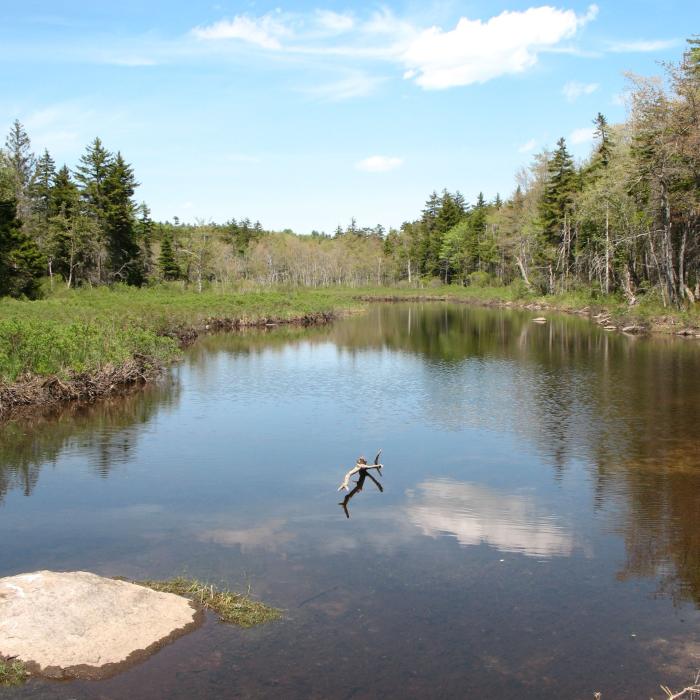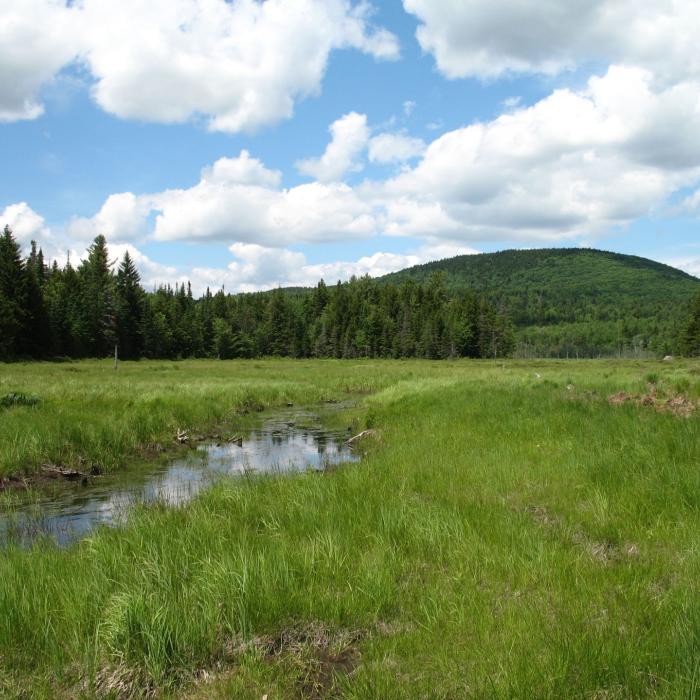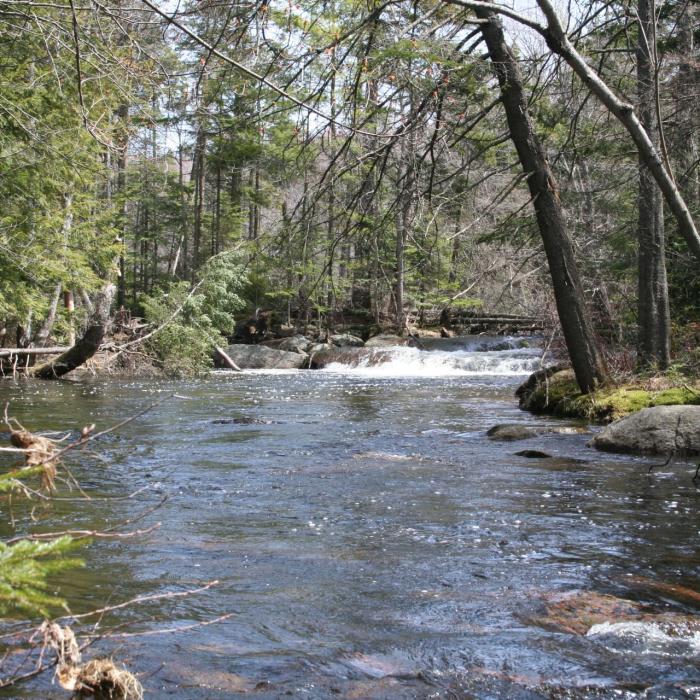About the Property
Spanning nearly 2,000 acres, the Ashuelot River Headwaters Forest includes superb mountain views and plenty of space for solitude. The trail up Silver Mountain climbs, sometimes steeply, through a pine, spruce, fir and mixed hardwood forest and eventually tops out at 2,160 feet with dramatic westward views of the village of Lempster and the Connecticut River Valley. A timber harvest was carefully conducted in 2021 to support new tree growth by increasing the amount of light reaching the forest floor.
Both Silver and Bean Mountains are within eyeshot of Mounts Monadnock, Sunapee, and Kearsarge – three iconic New Hampshire summits that the Forest Society worked to conserve. However, unlike these popular neighbors, the peaks of the Ashuelot River headwaters remain comparatively undiscovered by hiking crowds.
Silver Mountain
Directly north of Sand Pond, Silver Mountain has been hiked by the area’s year-round and summer residents for more than a century. The trail up the mountain climbs, sometimes steeply, through pines and hemlocks. Approaching the top, it opens up to blueberry bushes covering the flat height of land, mixing with long grass, granite, and a handful of stunted trees.
The most dramatic views are westward, overlooking the village of Lempster and the hills and hollows, farms and forests, and white Meetinghouse steeple of Acworth. Across the Connecticut River Valley, the distant peaks of Mount Ascutney and Vermont’s Green Mountains rise in the distance.
With barely a structure in sight, the rolling green landscape undulates northwest to Mt. Moosilaukee and Cardigan and south to the Wapack Range and Mount Monadnock. On a clear day, the Berkshires in Massachusetts are also visible. A short walk across rocky outcrops brings visitors to a good vantage point of Lovewell Mountain to the east and Mount Sunapee in the north.
This comparatively short trail to the top is frequented by the locals, who appreciate Silver Mountain’s blueberries, views, and the perspective that those views afford – being about to see the world from a vantage point accessible to only a few.
Bean Mountain
Bean Mountain remains the wilder of the two tracts that make up the Ashuelot River Headwaters Forest. As the source of the Ashuelot River, it includes more than 11,000 feet of frontage along the river, which supplies drinking water to the City of Keene and other downstream communities. The river and its many tributaries flow downhill through the spruce-fir and northern hardwood forests that give the land its northern “highlands” character, setting it apart from the hemlock-beech-oak-pine forests that make up most of the Ashuelot watershed.
The topography of the landscape varies dramatically, from summit of Bean Mountain to a high quality emergent marsh-shrub swamp, providing important habitat for a range of wildlife that include moose, deer, bear, songbirds, fisher, and bobcat, as well as river species such as native brook trout, mink, otter, waterfowl, and numerous reptiles and amphibians. Its rich wildlife resources have made the Ashuelot River Headwaters a conservation priority in several natural resource plans, including the bi-state Quabbin-to-Cardigan Conservation Plan, the NH Fish and Game Department’s Wildlife Action Plan, and the regional Ashuelot River Land Conservation Plan.
The land is part of a 10,000-acre block of forest that forms a critical link between two of the largest blocks of connected forest south of the White Mountains: the 25,000-acre Pillsbury-Sunapee Highlights, and the 11,000-acre Andorra Forest. The Bean Mountain Tract creates a bridge between Pillsbury State Park to the northeast and the Long Pond Town Forest to the southwest, building a large corridor of conserved, connected open space that allows individual creatures to continue to move between populations. Without this connectivity, the exchanges that ensure the long-term survival of species are choked off. Human activities, including road use and development, threaten to permanently separate animal populations.
Fishing Guide
If you like to hike and fish along the way, take a hike to Long Pond or Sand Pond on the Ashuelot Headwaters Forest in Lempster. This is a pleasant woodland walk, with a choice of either pond as a destination. Long Pond is managed by N.H. Fish and Game as a rainbow trout fishery, and Sand Pond is a cold and warm water (bass, etc.) fishery. At Sand Pond there is a public boat launch where you can put in your canoe or kayak and paddle north across the pond to the undeveloped shore of the Ashuelot Headwaters Forest and its large granite outcrops. The woodland trail also leads to these impressive rocks.
Property Details
The land is part of the estate that was owned for generations by the Wright family of Keene, which made its fortune in silver polish. Legend has it that John Wright’s first silver polish was developed in the late 1800s as the result of an accidental encounter with a cow on a muddy back road. Finding the cow mired in a bog, he enlisted a local farmer to free the animal. As he wiped dried mud from the cow’s bell, Wright discovered that the bell was brighter, as if it had been polished. He purchased the land containing the mud, part of which became known as Silver Mountain. By 1887 he had developed the dry powder into a cream that was eventually marketed as Wright’s Silver Polish.
Circumstances of acquisition:
The effort to conserve this special landscape was marked by a breadth of support that ranged from national and local foundations to hundreds of individuals. Some 500 people gave donations ranging from $10 to $500. The New Hampshire Snowmobile Association donated to protect a key snowmobile trail that runs through the Bean Mountain portion of the property. A local youth camp, Kroka Expeditions, also contributed, as did the local Sand Pond and Long Pond Associations.
The Lempster conservation commission played a key role in the project’s success. The commission members created a display that includes a map, photos, and literature about the project for Lempster’s town meeting. But they didn’t stop at the Lempster borders: they also contacted their colleagues in the nine other towns in the Ashuelot River watershed, providing letters and pamphlets about the proposed conservation project.
Early local support for the project helped the Forest Society to successfully secure the broader support necessary to complete a conservation project of this scope, including:
- The Land and Community Heritage Investment Program (LCHIP) granted $500,000.
- The New Hampshire Electric Coop Foundation awarded $10,000.
- Jane’s Trust, a regional trust which makes grants in Massachusetts, northern New England and Florida, granted $300,000 to the project.
- Saving New England's Wildlife, a multi-million dollar initiative of the Doris Duke Foundation and the Open Space Institute that funds the protection of areas identified as high-priority wildlife habitat by Maine, New Hampshire and Massachusetts in their State Wildlife Action Plans, contributed $250,000.
- The Landowner Incentive Program (LIP), administered by the NH Fish & Game Department, contributed $220,000.
- The Putnam Foundation granted the Forest Society $100,000. Based in Keene, the Putnam Foundation supports a number of causes, including programs that support ecological maintenance and conservation, particularly in the Monadnock Region.
- The Badger Fund—an advised fund of the New Hampshire Charitable Foundation—granted $50,000.
Please see our Visitor Use Guidelines page for a complete list of rules and regulations for Forest Society reservations
Trail Information
Silver Mountain Trail
Wooden Property Sign; Marked
NOTE: The Forest Society does not plow or guarantee access to this property or its parking areas during the winter. South Road is not maintained for winter travel.







